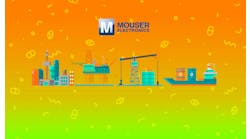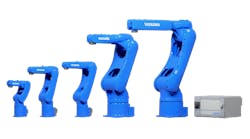Nothing new under the sun? Wrong. Plenty was new under the signature, orange hot-air balloon at the 30th edition of the biannual International Manufacturing Technology Show in mid-September at McCormick Place in Chicago. The event was the fourth largest in IMTS history and the largest six-day show ever with more than 114,000 registrants, who visited more than 2,000 exhibitors.
LESS ASSEMBLY REQUIRED
Technicians from Local Motors put together the world first 3D-printed car from parts produced by Cincinnati, Oak Ridge National Laboratory and students from the University of Tennessee.
Front and center was large-scale additive manufacturing in the form of the world's first 3D-printed car, which was printed and assembled on-site at the show. The project was a cooperative effort by Local Motors, Cincinnati Inc.; Oak Ridge National Laboratory; the University of Tennessee; and IMTS' Association for Manufacturing Technology (AMT). It began with Michele Anoe's "Strati" design, which was picked from 207 entries by Local Motors, and printed in successive 1/6-inch layers in just 44 hours by Cincinnati's new Big Area Additive Manufacturing (BAAM) machine. The resulting electric vehicle has a top speed of 40 mph, but only consists of about 40 parts, compared to the approximately 20,000 parts in a traditional car. [For more on Cincinnati's BAAM machine, read this issue's OEM Spotlight article on page 15.]Other machine innovators exhibiting at IMTS included:- Absolute Machine Tools, which showed how temperature-mapping techniques compensate for thermal changes in the axes of its Johnford Hi-Net high-speed machining (HSM) centers. To avoid part-distorting, accuracy-robbing heat, thermal sensors mounted on the HSM's machine casting and spindle head measure heat produced during cutting, and its controller's thermal-compensation system runs lengthy mathematical formulas, transfers data to the ladder logic and automatically adjusts the code to adjust for the thermal deviation caused by the heat. The controller then feeds new, on-the-fly offsets to the appropriate machine axis, so when a spindle grows by more than 0.003 mm, the control backs the cutting tool off of the part it's machining.
- Emag reported how it's migrated from large, custom-built equipment to smaller, more flexible, standard-concept machining centers for Tier 1 and 2 parts manufacturers. Marius Mazur, Emag's product line manager, reported its VL 2 produces parts up to 100-mm diameter, and its VL 4 makes parts up to 200-mm diameter, but they still retain the capability of its larger machines, such as employing Siemens' 840 DSL PLCs and Fanuc's 32i and 33i CNC controllers.
- DMG Mori exhibited numerous solutions in its huge booth, including its new Celos HMI panel that allows program debugging and access to Esprit's CAD and other design software right at the machine, and its Lasertec 65 3D machine that can perform 3D metal printing via a laser deposition process, and then perform machining functions all in one device.
- Mitsui Seiki demonstrated its flagship HU 100 5X five-axis machining center, which uses Fanuc's 31i controls and manufactures airplane landing gear and other enormous parts. Senior application and project engineer Bob Anderson reported HU 100 5X has a new spindle interface that's especially stiff and rigid, so it can work better with the machine's geared spindle, which "runs at low rpm, but very high torque for users who need to make deep cuts, but can get out fast."
- Lincoln Electric's Automation Solutions division showed robots, end-of-arm tooling, turning centers and positioners integrated in its new multi-process welding cells. "Traditional sequential processes move parts from cell to cell, but our transfer system and robots can simulate and perform three, four or five processes in one cell," says Eddie Ramsay, Lincoln's advanced welding sales manager. "We can even weld and pick up a part with the same tool."




